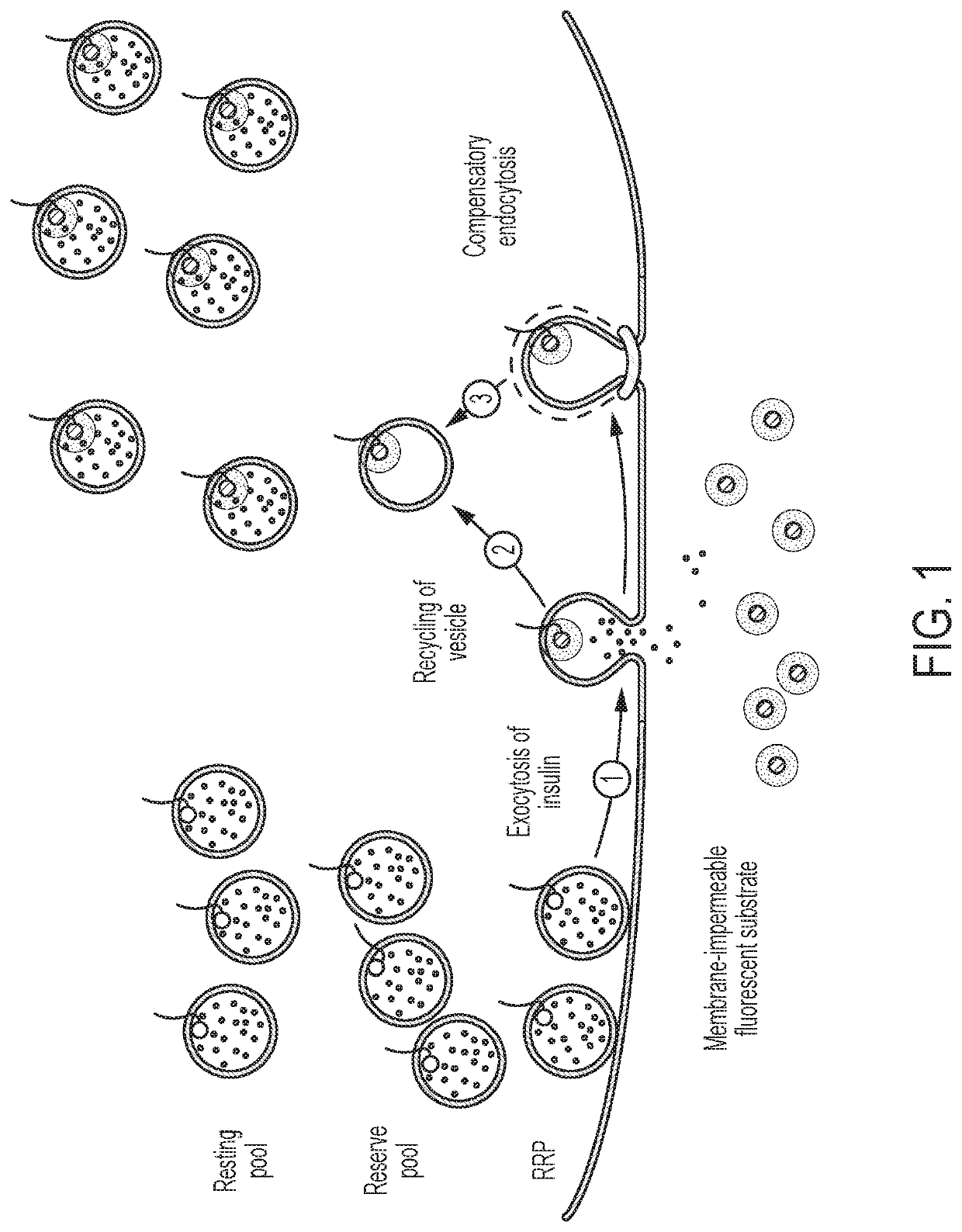Compositions for detecting secretion and methods of use
a technology of secretion and compositions, applied in the field of quantitative secretion, can solve the problems of limiting the applicability of modern genetic tools, too expensive and time-consuming assays to be useful for large-scale genome-wide chemical and genetic screening, and the inability to comprehensively interrogate the genes controlling secretion with existing assays,
- Summary
- Abstract
- Description
- Claims
- Application Information
AI Technical Summary
Benefits of technology
Problems solved by technology
Method used
Image
Examples
example 1
SynaptoSNAP System
[0249]Turning to FIG. 1, the regulated secretion of molecules can be measured in a cell-autonomous manner by tracking the flux of secretory vesicles to the cell membrane. The amount of a substance secreted through the regulated pathway is directly proportional to, and highly correlated with, the number of substance-containing vesicles that fuse with the cell membrane during exocytosis. By tracking the flow of vesicles to the cell membrane, Applicants can closely approximate the secretion of substances carried by those vesicles.
[0250]Applicants designed a system to accurately track the flux of vesicles using a tagged version of a protein in the synaptic vesicle membrane, synaptobrevin (a.k.a., vesicle-associated membrane protein-2, or VAMP2). The C-terminus of this transmembrane protein resides within the lumen of the vesicles, and becomes exposed to the extracellular environment when the vesicle fuses to the cell membrane during exocytosis. Applicants added a comme...
example 2
SynaptoSNAP Detects Secretion in Response to a Stimulus
[0252]Turning to FIGS. 2, 3 and 4, Applicants have used this reporter in the context of pancreatic beta cells to track insulin secretion in response to various stimuli. Applicants expressed synaptoSNAP in the INS-1E rat beta-cell line and show that fluorescence increases upon exposure to high glucose (FIG. 2). Moreover, the intensity of the fluorescence rises in proportion to the strength of stimulation, and in close correlation with insulin secretion, as measured by ELISA (Mercodia rat insulin ELISA) (FIG. 3). The intensity of cellular fluorescence is proportional to the degree of glucose stimulation and correlates well with the amount of insulin secreted as detected with an insulin ELISA.
[0253]Cells expressing the reporter eventually recover to their original non-fluorescent state, enabling the isolation of clones with improved assay characteristics, including greater change in fluorescence upon stimulation (FIG. 4). Shown is ...
example 3
Determining Genes Involved in the Secretion
[0254]The present invention may be used to determine genes or genetic elements involved in secretion. As an example, Applicants created a beta-cell line that expresses the reporter. The cell line can be interrogated with a genome-wide CRISPR nuclease library targeting the genes that are expressed in the beta cell by introducing the CRISPR library into the cells as described herein. Additionally, saturating mutagenesis libraries targeting functional DNA sequences, such as promoters, enhancers and repressors may be used. Genome-wide libraries targeting every gene in a genome may also be used. Such libraries are described herein. Genes discovered to regulate secretion of bioactive molecules represent potentially valuable drug targets. Pooled screens allow for high-throughput assessment of genes nominated by human genetics in disease pathophysiology. The library may contain guide RNAs that can be identified upon sequencing. Guide RNAs may be ex...
PUM
| Property | Measurement | Unit |
|---|---|---|
| wavelength | aaaaa | aaaaa |
| wavelength | aaaaa | aaaaa |
| volumes | aaaaa | aaaaa |
Abstract
Description
Claims
Application Information
 Login to View More
Login to View More - R&D
- Intellectual Property
- Life Sciences
- Materials
- Tech Scout
- Unparalleled Data Quality
- Higher Quality Content
- 60% Fewer Hallucinations
Browse by: Latest US Patents, China's latest patents, Technical Efficacy Thesaurus, Application Domain, Technology Topic, Popular Technical Reports.
© 2025 PatSnap. All rights reserved.Legal|Privacy policy|Modern Slavery Act Transparency Statement|Sitemap|About US| Contact US: help@patsnap.com



